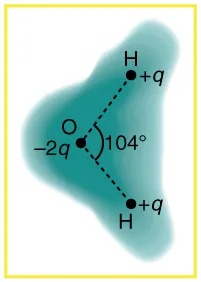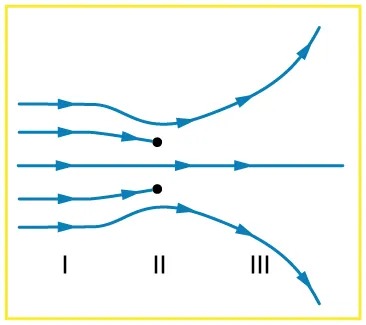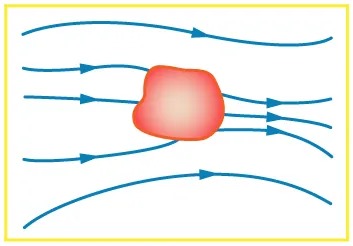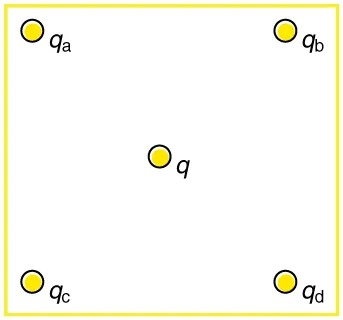Conceptual Questions
Conceptual Questions
15.1 Static Electricity and Charge: Conservation of Charge
- There are very large numbers of charged particles in most objects. Why, then, don’t most objects exhibit static electricity?
- Why do most objects tend to contain nearly equal numbers of positive and negative charges?
15.2 Conductors and Insulators
- An eccentric inventor attempts to levitate by first placing a large negative charge on himself and then putting a large positive charge on the ceiling of his workshop. Instead, while attempting to place a large negative charge on himself, his clothes fly off. Explain.
- If you have charged an electroscope by contact with a positively charged object, describe how you could use it to determine the charge of other objects. Specifically, what would the leaves of the electroscope do if other charged objects were brought near its knob?
- When a glass rod is rubbed with silk, it becomes positive and the silk becomes negative—yet both attract dust. Does the dust have a third type of charge that is attracted to both positive and negative? Explain.
- Why does a car always attract dust right after it is polished? (Note that car wax and car tires are insulators.)
- Describe how a positively charged object can be used to give another object a negative charge. What is the name of this process?
- What is grounding? What effect does it have on a charged conductor? On a charged insulator?
15.3 Coulomb’s Law
- Figure 15.39 shows the charge distribution in a water molecule, which is called a polar molecule because it has an inherent separation of charge. Given water’s polar character, explain what effect humidity has on removing excess charge from objects.

Figure 15.39 Schematic representation of the outer electron cloud of a neutral water molecule. The electrons spend more time near the oxygen than the hydrogens, giving a permanent charge separation as shown. Water is thus a polar molecule. It is more easily affected by electrostatic forces than molecules with uniform charge distributions. Image from OpenStax College Physics 2e, CC-BY 4.0
Image Description
The image depicts a molecule of water (H₂O) with a stylized representation. It shows an oxygen atom (O) at the center with a partial negative charge indicated as -2q, and two hydrogen atoms (H) each with a partial positive charge indicated as +q. The hydrogen atoms are connected to the oxygen atom by dashed lines representing covalent bonds. The bond angle between the two hydrogen atoms is labeled as 104 degrees, illustrating the bent molecular shape of water. The whole structure is shown within a shaded area that represents the approximate electron cloud distribution.
- Using Figure 15.39, explain, in terms of Coulomb’s law, why a polar molecule (such as in Figure 15.39) is attracted by both positive and negative charges.
- Given the polar character of water molecules, explain how ions in the air form nucleation centers for rain droplets.
15.4 Electric Field: Concept of a Field Revisited
- Why must the test charge [latex]q[/latex] in the definition of the electric field be vanishingly small?
- Are the direction and magnitude of the Coulomb force unique at a given point in space? What about the electric field?
15.5 Electric Field Lines: Multiple Charges
- Compare and contrast the Coulomb force field and the electric field. To do this, make a list of five properties for the Coulomb force field analogous to the five properties listed for electric field lines. Compare each item in your list of Coulomb force field properties with those of the electric field—are they the same or different? (For example, electric field lines cannot cross. Is the same true for Coulomb field lines?)
- Figure 15.40 shows an electric field extending over three regions, labeled I, II, and III. Answer the following questions. (a) Are there any isolated charges? If so, in what region and what are their signs? (b) Where is the field strongest? (c) Where is it weakest? (d) Where is the field the most uniform?

Figure 15.40 Image from OpenStax College Physics 2e, CC-BY 4.0
Image Description
The image depicts a diagram with a series of blue arrows illustrating fluid or traffic flow. The arrows are organized into three distinct sections, labeled I, II, and III below the lines.
– On the left side, several straight horizontal arrows approach from a distance.
– As the arrows move rightward, they encounter black dots. Some arrows curve around these dots while others pass through them.
– In section I, the arrows diverge, splitting into different paths.
– In section II, the arrows converge and align into a single path.
– In section III, the arrows diverge again, similar to section I but with a downward curve.
This diagram may represent a concept of flow dynamics, traffic patterns, or a similar process involving movement and directionality.
15.6 Electric Forces in Biology
- A cell membrane is a thin layer enveloping a cell. The thickness of the membrane is much less than the size of the cell. In a static situation the membrane has a charge distribution of [latex]- 2 . 5 \times \text{10}^{- 6}[/latex]C/m 2 on its inner surface and [latex]+ 2 . 5 \times \text{10}^{- 6}[/latex] C/m2 on its outer surface. Draw a diagram of the cell and the surrounding cell membrane. Include on this diagram the charge distribution and the corresponding electric field. Is there any electric field inside the cell? Is there any electric field outside the cell?
15.7 Conductors and Electric Fields in Static Equilibrium
- Is the object in Figure 15.41 a conductor or an insulator? Justify your answer.

Figure 15.41 Image from OpenStax College Physics 2e, CC-BY 4.0
Image Description
The image contains a conceptual diagram illustrating fluid dynamics around an object. There is a reddish, irregularly-shaped object in the center. Blue arrows, representing fluid flow lines, are curving around the object. The arrows are longer and straighter before reaching the object and then they curve around it, becoming closer together behind the object, indicating the flow’s continuity and deflection due to the obstruction. The background is white and there is a yellow border around the image.
- If the electric field lines in the figure above were perpendicular to the object, would it necessarily be a conductor? Explain.
- The discussion of the electric field between two parallel conducting plates, in this module states that edge effects are less important if the plates are close together. What does close mean? That is, is the actual plate separation crucial, or is the ratio of plate separation to plate area crucial?
- Would the self-created electric field at the end of a pointed conductor, such as a lightning rod, remove positive or negative charge from the conductor? Would the same sign charge be removed from a neutral pointed conductor by the application of a similar externally created electric field? (The answers to both questions have implications for charge transfer utilizing points.)
- Why is a golfer with a metal club over her shoulder vulnerable to lightning in an open fairway? Would she be any safer under a tree?
- Can the belt of a Van de Graaff accelerator be a conductor? Explain.
- Are you relatively safe from lightning inside an automobile? Give two reasons.
- Discuss pros and cons of a lightning rod being grounded versus simply being attached to a building.
- Using the symmetry of the arrangement, show that the net Coulomb force on the charge [latex]q[/latex] at the center of the square below (Figure 15.42) is zero if the charges on the four corners are exactly equal.

Figure 15.42 Four point charges [latex]q_{a}[/latex], [latex]q_{b}[/latex], [latex]q_{c}[/latex], and [latex]q_{d}[/latex] lie on the corners of a square and [latex]q[/latex] is located at its center. Image from OpenStax College Physics 2e, CC-BY 4.0
Image Description
The image displays a geometrical diagram consisting of five circles, each filled with yellow color and outlined in black, positioned on a white background with a thin yellow border. Four of these circles are located near the corners of the square-shaped area, and one is at the center.
- Top left corner: Circle labeled as “qa“
- Top right corner: Circle labeled as “qb“
- Bottom left corner: Circle labeled as “qc“
- Bottom right corner: Circle labeled as “qd“
- Center of the square: Circle labeled as “q”
- (a) Using the symmetry of the arrangement, show that the electric field at the center of the square in Figure 15.42 is zero if the charges on the four corners are exactly equal. (b) Show that this is also true for any combination of charges in which [latex]q_{a} = q_{d}[/latex] and [latex]q_{b} = q_{c}[/latex]
- (a) What is the direction of the total Coulomb force on [latex]q[/latex] in Figure 15.42 if [latex]q[/latex] is negative, [latex]q_{a} = q_{c}[/latex] and both are negative, and [latex]q_{b} = q_{d}[/latex] and both are positive? (b) What is the direction of the electric field at the center of the square in this situation?
- Considering Figure 15.42, suppose that [latex]q_{a} = q_{d}[/latex] and [latex]q_{b} = q_{c}[/latex]. First show that [latex]q[/latex] is in static equilibrium. (You may neglect the gravitational force.) Then discuss whether the equilibrium is stable or unstable, noting that this may depend on the signs of the charges and the direction of displacement of [latex]q[/latex] from the center of the square.
- If [latex]q_{a} = 0[/latex] in Figure 15.42, under what conditions will there be no net Coulomb force on [latex]q[/latex]?
- In regions of low humidity, one develops a special “grip” when opening car doors, or touching metal door knobs. This involves placing as much of the hand on the device as possible, not just the ends of one’s fingers. Discuss the induced charge and explain why this is done.
- Tollbooth stations on roadways and bridges usually have a piece of wire stuck in the pavement before them that will touch a car as it approaches. Why is this done?
- Suppose a person carries an excess charge. To maintain their charged status can they be standing on ground wearing just any pair of shoes? How would you discharge them? What are the consequences if they simply walk away?

